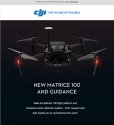Which model are you using? I understand DJI has not yet released their proprietary follow-me feature. Do Phantom users have to use third party addon if they need one? Is there any information on the range, endurance and payload of the Matrice 100?
DJI's new Matrice 100 drone avoids obstacles and flies for 40 minutes at a time
By
June 8, 2015
A project at Shanghai's Fudan University demosntrates Guidance's capabilities by identifying illegally parked cars from above
Getting to grips with piloting a drone can involve a steep and expensive learning curve. How these vehicles can be made to avoid crashing into stuff is a question that has plagued the technology from the outset. But the world's largest drone maker DJI says it has now developed a solution. Simply called Guidance, its obstacle avoidance system integrates with its new developer-focused Matrice 100 quadcopter and promises to make busted rotor-blades a thing of the past.
Building functional and reliable obstacle avoidance systems has been something of a focus for drone-makers looking to get out ahead of the pack. Last year's
, which raised more then US$1 million on Kickstarter, delayed shipping as it worked to refine its promised obstacle avoidance system. In February this year, a team of Swiss technologists won the US$1 million Drones for Good competition with a quadcopter that flies
to safely travel through confined spaces. There are even obstacle-detecting sonar systems in the works that can be
to make them safer to fly.
So perhaps it was just a matter of time before industry heavyweight DJI came to the party with what it claims is the first commercially-available collision avoidance system for drones. Guidance relies on an array of ultrasonic sensors and stereo cameras to detect when the drone flies too close to objects, with this range configurable and can extend to 20 m (65 ft).
It consists of a programmable hardware attachment that DJI says can be mounted to any robotic system with USB and UART connection ports. As proof of the system's capabilities, the company points to a project at Shanghai's Fudan University, where researchers combined Guidance with Intel processors to identify illegally parked cars from above.
The project is designed to help city workers sniff out dodgy parking jobs, all while the drone avoids lamp posts and trees. The system works by determining the position and orientation of a parked car, and if deemed unsatisfactory, snapping a photo of the license plate and relaying it back to a central database.
DJI rolled out Guidance as part of a wider announcement detailing, among other things, its new Matrice 100 quadcopter for developers. Where its earlier drone models have generally been designed with specific users in mind (largely beginner to professional aerial photographers), the Matrice 100 is billed as something of a blank canvas for researchers to bring their own ideas to life.
Ready to fly out of the box with dual battery slots and a whopping 40 minutes flight time, the Matrice 100 features several communication ports, power supply leads and expansion bays for extras components, so that additional hardware can be fixed to the drone to afford it new functionality.
"We're excited to see how researchers and developers will use this platform to test how aerial technology can be used for agriculture, inspection, search and rescue and several other fields," says Frank Wang, DJI CEO.
DJI also announced SDKs for both the
and
quadcopters, aimed at offering developers with bright ideas a way to bringing innovative applications and functionality to the drones.
DJI will begin shipping both the Matrice 100 and Guidance system at the end of June. The Matrice 100 will be priced at $3,299 and Guidance will cost $999.
Source: DJI
,











